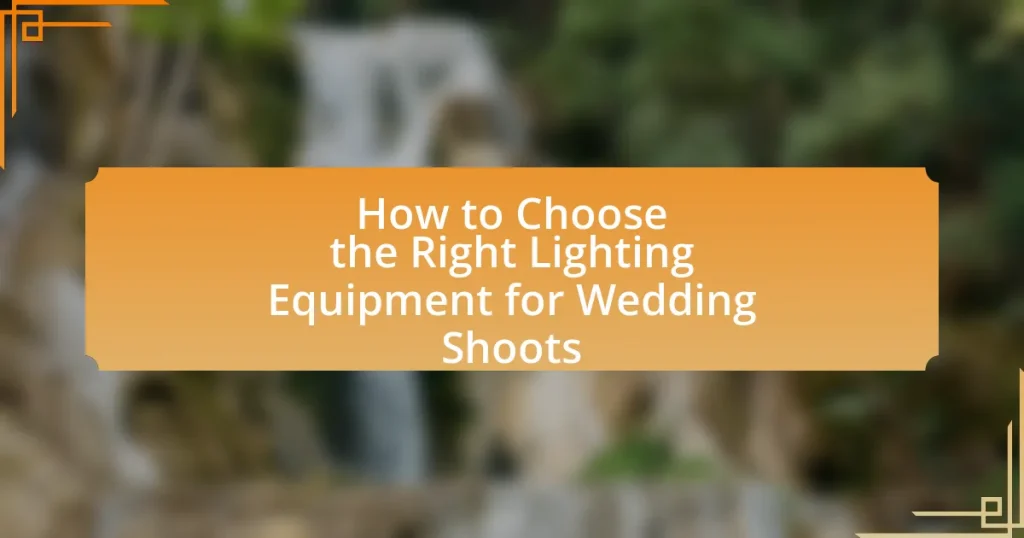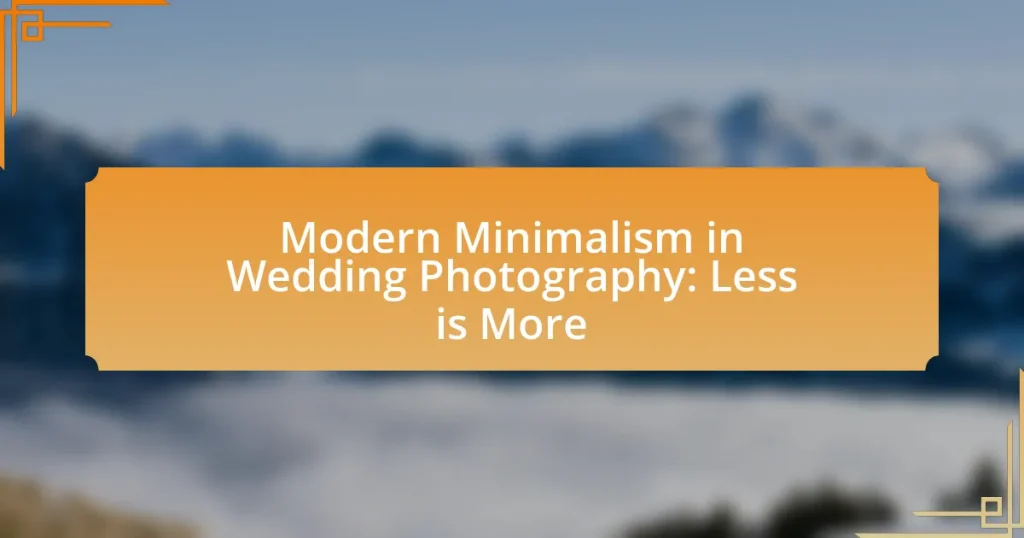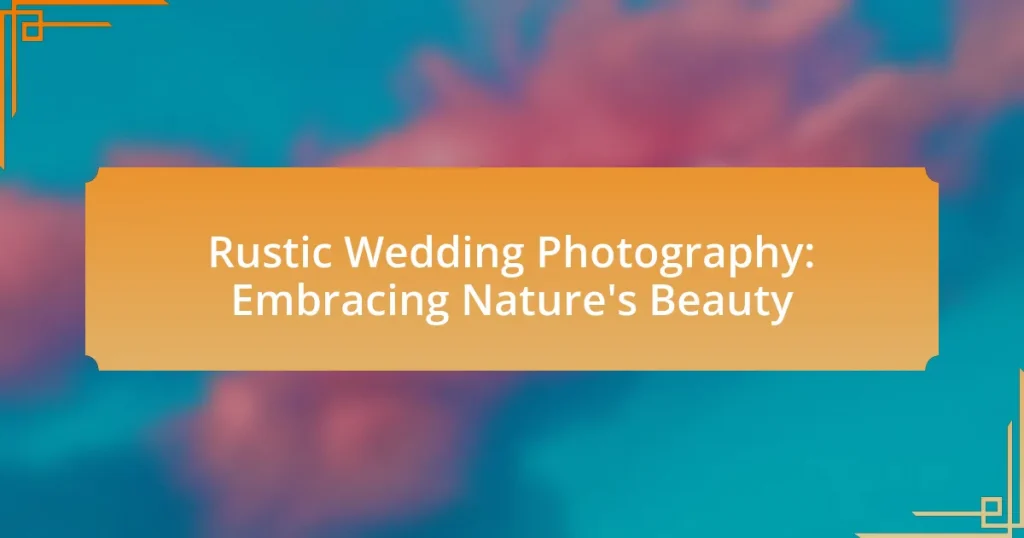The article focuses on selecting the appropriate lighting equipment for wedding shoots, emphasizing critical factors such as lighting type, portability, power source, and color temperature. It explores how venue characteristics influence lighting choices, addressing challenges faced in both indoor and outdoor settings. The piece details various lighting equipment options, including continuous lights and flash, and discusses techniques to enhance lighting quality, such as using softboxes and reflectors. Additionally, it highlights the importance of understanding color temperature and provides best practices for effective lighting setup, troubleshooting common issues, and avoiding common mistakes in lighting selection.
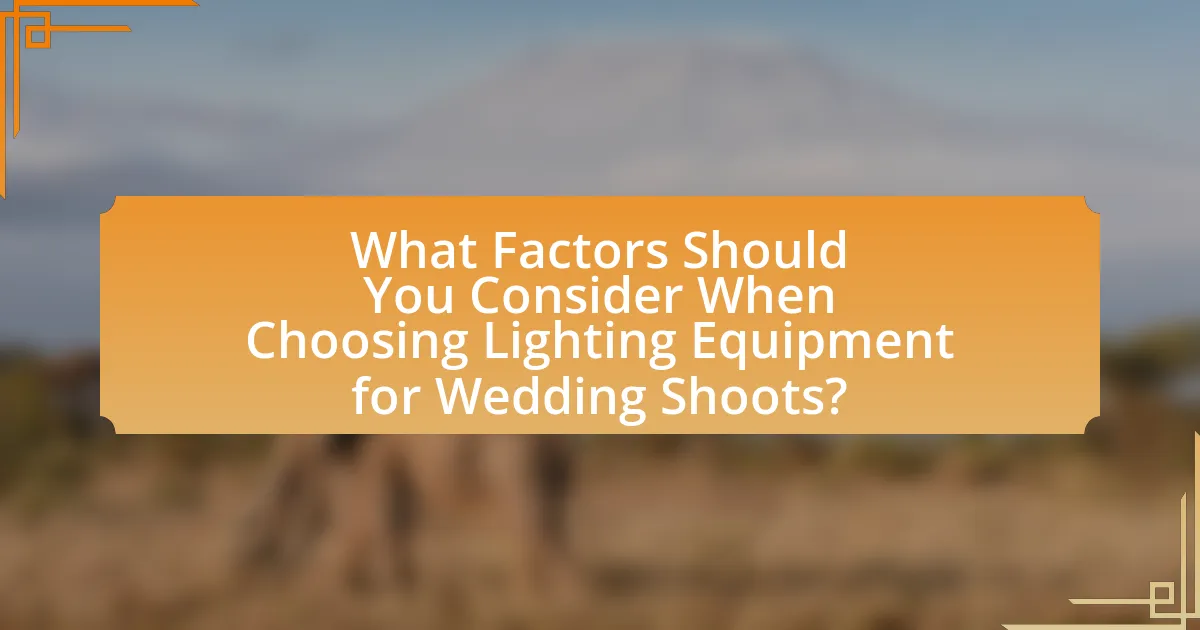
What Factors Should You Consider When Choosing Lighting Equipment for Wedding Shoots?
When choosing lighting equipment for wedding shoots, consider the type of lighting, portability, power source, and color temperature. The type of lighting, such as continuous or flash, affects how you capture moments; continuous lighting allows for real-time adjustments, while flash can freeze action. Portability is crucial since weddings often involve moving between locations; lightweight and compact equipment facilitates easy transport. The power source, whether battery-operated or AC-powered, impacts your ability to shoot in various settings, especially outdoors. Lastly, color temperature influences the mood of your images; equipment with adjustable color temperature provides flexibility to match different lighting conditions. These factors collectively ensure that you achieve the desired aesthetic and functionality during wedding shoots.
How does the venue affect your lighting equipment choice?
The venue significantly influences the choice of lighting equipment due to factors such as size, layout, and existing lighting conditions. For instance, a large outdoor venue may require powerful, portable lights to ensure adequate illumination, while a smaller indoor venue might benefit from softer, more diffused lighting options. Additionally, venues with high ceilings may necessitate the use of lighting fixtures that can project light effectively from a distance, whereas venues with low ceilings might require more compact lighting solutions. The existing ambient light in the venue also plays a crucial role; venues with ample natural light may need less artificial lighting, while darker venues will require more robust lighting setups to achieve the desired effect.
What are the lighting challenges in indoor venues?
Indoor venues face several lighting challenges, including inadequate natural light, uneven light distribution, and the presence of harsh shadows. Inadequate natural light can lead to reliance on artificial lighting, which may not always provide the desired ambiance. Uneven light distribution can create areas that are either overexposed or underexposed, complicating photography and videography. Harsh shadows can detract from the overall aesthetic, making it difficult to capture flattering images. These challenges necessitate careful planning and selection of appropriate lighting equipment to ensure optimal results during wedding shoots.
How do outdoor settings influence lighting decisions?
Outdoor settings significantly influence lighting decisions by dictating the natural light conditions and the overall ambiance of the environment. Factors such as time of day, weather, and location impact the quality and direction of light, which in turn affects the choice of artificial lighting equipment. For instance, during golden hour, the warm, diffused sunlight can enhance the aesthetic of wedding photos, reducing the need for additional lighting. Conversely, harsh midday sun may require the use of reflectors or diffusers to soften shadows and balance exposure. Additionally, outdoor venues with varying backdrops, such as gardens or beaches, necessitate different lighting setups to complement the surroundings and achieve the desired visual effect.
What types of lighting equipment are available for wedding photography?
Various types of lighting equipment are available for wedding photography, including speedlights, studio strobes, continuous lights, and reflectors. Speedlights are portable flash units that can be mounted on cameras or used off-camera, providing versatility in different lighting conditions. Studio strobes offer powerful bursts of light and are ideal for controlled environments, while continuous lights allow photographers to see the lighting effect in real-time, making them useful for video as well. Reflectors help bounce existing light to fill shadows and enhance the overall lighting quality. Each type of equipment serves specific purposes, allowing photographers to adapt to various settings and achieve desired effects.
What are the differences between continuous and flash lighting?
Continuous lighting provides a constant light source, allowing photographers to see how the light affects the scene in real-time, which is beneficial for adjusting settings and compositions. In contrast, flash lighting emits a brief burst of light, which can freeze motion and create a different aesthetic but requires the photographer to anticipate the moment of capture since the light is not visible until the flash fires. Continuous lighting is often preferred for video and situations requiring consistent illumination, while flash lighting is favored for still photography, particularly in low-light conditions, due to its ability to produce high-intensity light in a short duration.
How do softboxes and umbrellas enhance lighting quality?
Softboxes and umbrellas enhance lighting quality by diffusing light, which reduces harsh shadows and creates a softer, more flattering illumination. Softboxes achieve this by enclosing the light source and using a diffusion material, resulting in a controlled spread of light that mimics natural lighting conditions. Umbrellas, on the other hand, reflect and diffuse light, allowing for a broader light source that also softens shadows. Both tools are essential in photography, particularly in wedding shoots, as they help to create a more aesthetically pleasing and even light, which is crucial for capturing the delicate details and emotions of the event.
Why is understanding the color temperature important for wedding shoots?
Understanding color temperature is crucial for wedding shoots because it directly affects the mood and aesthetic of the photographs. Different light sources emit varying color temperatures, measured in Kelvin, which can influence skin tones and the overall ambiance of the images. For instance, daylight has a color temperature around 5500K, providing a natural look, while tungsten light is around 3200K, giving a warmer tone. Accurate knowledge of these temperatures allows photographers to select appropriate lighting equipment and adjust settings to ensure consistent and flattering results, enhancing the visual storytelling of the wedding day.
What is the ideal color temperature for different wedding settings?
The ideal color temperature for different wedding settings typically ranges from 2700K to 6000K. For indoor ceremonies, a warm color temperature of around 2700K to 3000K creates a cozy and intimate atmosphere, suitable for venues like churches or banquet halls. Outdoor settings during golden hour benefit from a color temperature of approximately 4000K to 5000K, which captures the natural warmth of sunset lighting. For bright daylight outdoor weddings, a cooler color temperature of 5000K to 6000K is ideal, as it mimics the natural daylight and enhances colors without distortion. These ranges are supported by lighting design principles that emphasize the emotional impact of color temperature on ambiance and mood.
How can you adjust color temperature during a shoot?
To adjust color temperature during a shoot, use adjustable lighting equipment such as LED lights with color temperature controls or gels that can be placed over light sources. These tools allow photographers to modify the warmth or coolness of the light, ensuring it matches the desired aesthetic or the ambient light conditions. For instance, LED lights often have settings that range from 2700K (warm) to 6500K (cool), enabling precise adjustments. This capability is crucial in wedding photography, where lighting conditions can vary significantly throughout the day, affecting skin tones and overall image quality.
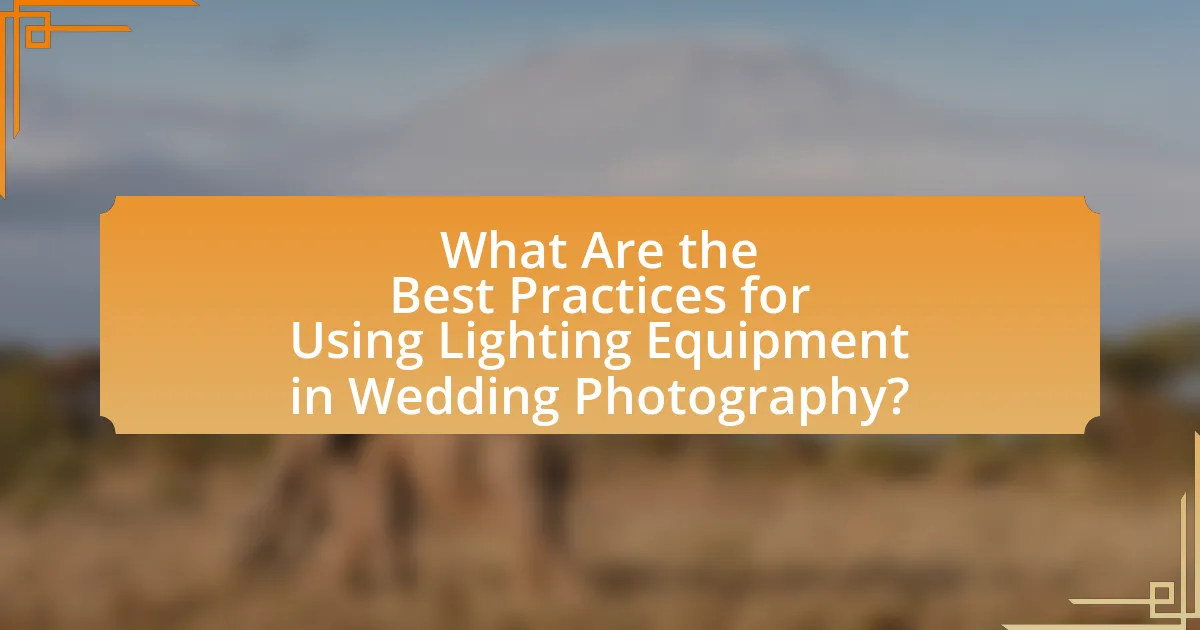
What Are the Best Practices for Using Lighting Equipment in Wedding Photography?
The best practices for using lighting equipment in wedding photography include understanding the venue’s lighting conditions, utilizing soft light sources, and employing off-camera flash techniques. Photographers should assess natural light availability and adjust their equipment accordingly to enhance the overall ambiance. Soft light sources, such as diffusers or softboxes, help create flattering portraits by minimizing harsh shadows. Off-camera flash techniques allow for greater control over lighting direction and intensity, enabling photographers to achieve more dynamic compositions. These practices are supported by the fact that well-lit images significantly improve the quality of wedding photography, as evidenced by numerous professional guidelines and industry standards.
How can you effectively position lighting equipment for optimal results?
To effectively position lighting equipment for optimal results, place the lights at a 45-degree angle to the subject to create flattering shadows and depth. This positioning helps to illuminate the subject evenly while avoiding harsh shadows that can detract from the overall image quality. Additionally, using softboxes or diffusers can further soften the light, enhancing the aesthetic appeal of wedding photographs. Studies in photography emphasize that proper light positioning significantly impacts the mood and clarity of images, making it essential for capturing the essence of wedding moments.
What are the best angles for lighting to avoid harsh shadows?
The best angles for lighting to avoid harsh shadows are typically at a 45-degree angle from the subject and slightly above eye level. This positioning softens the light and minimizes the contrast between light and shadow, reducing the appearance of harsh shadows on the subject’s face. Additionally, using diffusers or softboxes can further soften the light, enhancing the overall quality of the illumination. Studies in photography emphasize that lighting from above and at an angle creates a more flattering effect, particularly in portraiture, which is crucial for wedding shoots.
How does the distance from the subject affect lighting quality?
The distance from the subject significantly affects lighting quality by altering the intensity and softness of the light. As the distance increases, the light intensity decreases due to the inverse square law, which states that light intensity diminishes with the square of the distance from the source. For example, if a light source is moved from 1 meter to 2 meters away, the intensity of the light reaching the subject is reduced to one-fourth of its original strength. Additionally, greater distances can lead to harsher shadows and less diffusion, resulting in a less flattering appearance for subjects. Therefore, managing the distance between the light source and the subject is crucial for achieving optimal lighting quality in wedding photography.
What techniques can enhance the use of lighting equipment during a wedding shoot?
Techniques that can enhance the use of lighting equipment during a wedding shoot include utilizing softboxes to diffuse light, employing reflectors to bounce light onto subjects, and adjusting the color temperature to match ambient lighting. Softboxes create a softer, more flattering light that reduces harsh shadows, which is essential for capturing the delicate features of the bride and groom. Reflectors can enhance natural light by redirecting it, providing additional illumination without the need for extra equipment. Adjusting the color temperature ensures that the lighting complements the venue’s existing light, maintaining a cohesive look in photographs. These techniques are widely recognized in photography as effective methods to improve lighting quality and overall image aesthetics.
How can you use reflectors to improve lighting?
Reflectors can be used to improve lighting by redirecting natural or artificial light onto subjects, enhancing illumination and reducing shadows. By positioning reflectors strategically, photographers can bounce light onto the subject, creating a more flattering and even light distribution. For instance, using a white reflector can soften harsh sunlight, while a silver reflector can increase brightness and contrast. Studies in photography demonstrate that reflectors can significantly enhance image quality by providing controlled lighting, making them an essential tool for wedding shoots.
What role does natural light play in conjunction with artificial lighting?
Natural light enhances the effectiveness of artificial lighting by providing a balanced and dynamic illumination that can create a more aesthetically pleasing environment. When used together, natural light can soften harsh shadows created by artificial sources, resulting in a more flattering appearance for subjects in wedding photography. Studies indicate that utilizing both light sources can improve the overall quality of images, as natural light contributes to the color temperature and mood, while artificial lighting can fill in dark areas and provide control over exposure. This combination allows photographers to achieve a harmonious blend of light that captures the essence of the moment while ensuring subjects are well-lit and visually appealing.
Why is it important to practice with your lighting equipment before the wedding day?
Practicing with lighting equipment before the wedding day is crucial for ensuring optimal performance during the event. Familiarity with the equipment allows photographers to understand its capabilities and limitations, which is essential for capturing high-quality images in varying lighting conditions. For instance, knowing how to adjust settings for different environments can prevent issues such as overexposure or underexposure, which can compromise the final photographs. Additionally, practice sessions enable photographers to troubleshoot potential problems, such as equipment malfunctions or inadequate lighting setups, thereby reducing stress on the wedding day. This preparation ultimately leads to more confident and efficient shooting, resulting in better overall outcomes for the wedding photography.
What are the benefits of conducting a lighting test shoot?
Conducting a lighting test shoot allows photographers to evaluate how different lighting setups affect the final image quality. This practice helps in identifying the most flattering light for subjects, ensuring that skin tones are accurately represented and that the overall mood aligns with the desired aesthetic. Additionally, a lighting test shoot provides an opportunity to experiment with various equipment, such as softboxes or reflectors, allowing photographers to understand their effects on shadows and highlights. By analyzing the results, photographers can make informed decisions about lighting equipment and techniques, ultimately enhancing the quality of wedding photography.
How can you troubleshoot common lighting issues during a shoot?
To troubleshoot common lighting issues during a shoot, first assess the lighting conditions and identify the specific problem, such as harsh shadows, overexposure, or color imbalance. For harsh shadows, reposition the light source or use diffusers to soften the light. If overexposure occurs, adjust the camera settings, such as lowering the ISO or aperture, or move the light source further away. For color imbalance, use gels on lights to correct the color temperature or adjust the white balance settings on the camera. These methods are effective as they directly address the common issues photographers face, ensuring optimal lighting for wedding shoots.
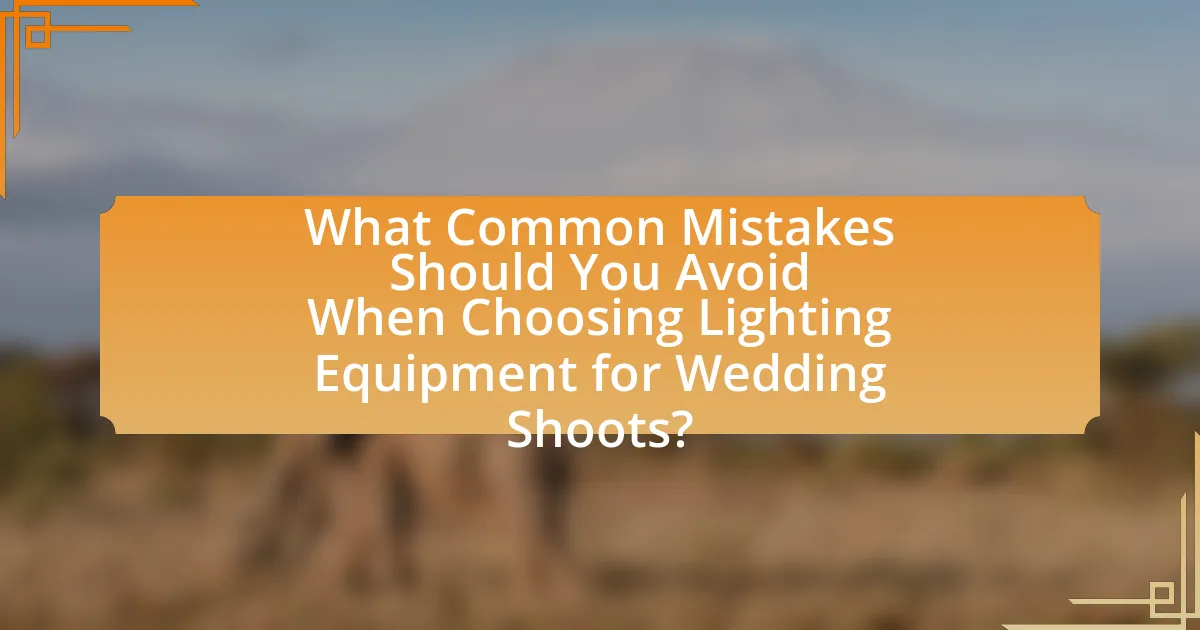
What Common Mistakes Should You Avoid When Choosing Lighting Equipment for Wedding Shoots?
When choosing lighting equipment for wedding shoots, avoid the common mistake of not considering the venue’s lighting conditions. Many photographers overlook how ambient light affects their choice of equipment, leading to inadequate lighting for the event. Additionally, failing to test equipment before the wedding day can result in unexpected issues, such as equipment malfunction or unsatisfactory light quality. Another mistake is not having a backup plan; relying solely on one type of lighting can be risky if it fails. Lastly, neglecting to consider the style and mood of the wedding can lead to mismatched lighting choices, which may not complement the overall aesthetic.
What are the pitfalls of relying solely on natural light?
Relying solely on natural light can lead to inconsistent lighting conditions, which may negatively impact the quality of wedding photographs. Natural light varies throughout the day and can be affected by weather changes, resulting in harsh shadows or overexposed highlights. For instance, during midday, sunlight can create unflattering contrasts, while overcast days may produce flat images lacking depth. Additionally, the limited control over natural light can hinder a photographer’s ability to achieve desired effects, such as softening shadows or enhancing colors, ultimately compromising the overall aesthetic of the wedding shoot.
How can changing weather conditions impact your lighting setup?
Changing weather conditions can significantly impact your lighting setup by altering the quality and intensity of natural light available during a wedding shoot. For instance, overcast skies diffuse sunlight, resulting in softer shadows and a more even light distribution, which can enhance skin tones and reduce harsh contrasts. Conversely, bright sunlight can create strong shadows and highlights, necessitating the use of reflectors or diffusers to manage the light effectively. Additionally, rain or fog can introduce a unique atmospheric quality, but may require adjustments in artificial lighting to maintain visibility and clarity. These variations in weather necessitate flexibility in lighting equipment choices, such as portable flash units or LED panels, to adapt to the changing conditions and ensure optimal image quality.
What are the risks of using inadequate lighting equipment?
Using inadequate lighting equipment poses several risks, including poor image quality, increased post-production time, and potential safety hazards. Poor image quality arises from insufficient light, leading to underexposed or grainy photos, which can detract from the overall aesthetic of wedding images. Increased post-production time occurs as photographers may need to spend additional hours correcting exposure issues or enhancing images that lack clarity. Safety hazards can arise in low-light conditions, increasing the risk of accidents for both the photographer and subjects, as visibility is compromised. These risks highlight the importance of selecting appropriate lighting equipment to ensure high-quality results and a safe shooting environment during wedding shoots.
How can overcomplicating your lighting setup affect your shoot?
Overcomplicating your lighting setup can lead to confusion and inefficiency during a shoot. When a lighting setup is overly complex, it increases the likelihood of technical issues, such as equipment malfunctions or miscommunication among the crew, which can disrupt the flow of the shoot. Additionally, a complicated setup can consume valuable time that could be spent capturing moments, ultimately affecting the quality and spontaneity of the images. Studies in photography workflows indicate that simpler setups often yield better results, as they allow for quicker adjustments and a more focused creative process.
What are the disadvantages of using too many light sources?
Using too many light sources can lead to excessive brightness and harsh shadows, which can negatively impact the quality of wedding photographs. Over-illumination can cause subjects to squint and create unflattering highlights on skin, detracting from the overall aesthetic. Additionally, multiple light sources can complicate the lighting setup, making it difficult to achieve a balanced and cohesive look. This complexity can also increase the risk of equipment failure or misalignment, resulting in inconsistent lighting across images.
How can you simplify your lighting approach for better results?
To simplify your lighting approach for better results, focus on using a limited number of versatile lighting tools, such as softboxes and reflectors, which can adapt to various situations. This strategy reduces complexity by minimizing the equipment needed while maximizing the quality of light produced. For instance, softboxes diffuse light effectively, creating a flattering and even illumination that is ideal for wedding photography. Additionally, reflectors can bounce natural light, enhancing shadows and highlights without requiring additional gear. By consolidating your lighting setup, you streamline the shooting process, allowing for quicker adjustments and more consistent results.
What practical tips can help you choose the right lighting equipment for wedding shoots?
To choose the right lighting equipment for wedding shoots, prioritize versatility and portability. Versatile lighting options, such as speedlights and softboxes, allow for adaptability in various settings, from indoor venues to outdoor ceremonies. Portability is crucial, as wedding photographers often need to move quickly between locations; lightweight and compact equipment facilitates this. Additionally, consider the color temperature of the lights, aiming for options that can match ambient lighting conditions, ensuring a cohesive look in photographs. Finally, test the equipment in similar environments before the event to ensure it meets your specific needs, as practical experience can reveal strengths and weaknesses not apparent in specifications alone.
How do you determine your budget for lighting equipment?
To determine your budget for lighting equipment, first assess your overall wedding shoot budget and allocate a specific percentage for lighting, typically ranging from 10% to 20%. This allocation should consider the scale of the event, the number of lighting setups required, and the quality of equipment desired. For instance, if your total budget is $10,000, setting aside $1,000 to $2,000 for lighting equipment is reasonable. Additionally, research the costs of various lighting options, such as LED lights, softboxes, and reflectors, to ensure your budget aligns with the necessary equipment for achieving the desired lighting effects.
What are the key features to look for in wedding lighting gear?
Key features to look for in wedding lighting gear include adjustable brightness, color temperature control, portability, and battery life. Adjustable brightness allows for customization based on the venue’s lighting conditions, while color temperature control ensures that the lighting complements the wedding’s aesthetic, typically ranging from warm to cool tones. Portability is crucial for ease of setup and transport, especially in diverse locations, and a good battery life is essential for uninterrupted operation throughout the event. These features collectively enhance the quality of wedding photography and videography, ensuring that the captured moments are beautifully illuminated.
